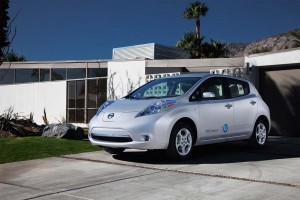
Battery vehicles like the Leaf would have to be emit warning sounds at low speeds under the proposed rules.
Whining has always been a sound prized by the world’s automakers who over the years have stoutly resisted suggestions from governments, civic groups and consumer advocates that might make cars safer to operate in congested environments.
So it’s really no surprise major automakers — including domestic, Asian and European companies who generally can’t agree on what color blue is – are all complaining in unison about the Obama administration’s recommendation to alert pedestrians to oncoming electric cars and other nearly silent vehicles.
The carmakers originally backed the idea but now claim the National Highway Traffic Safety Administration’s proposed rules mandating minimum sound levels intended to warn the visually impaired — as well as bicyclists and other pedestrians — are way too onerous.
The rule “is too complicated and is unnecessarily prescriptive. If implemented as proposed, it would result in alert sounds that are louder than necessary, create driver and occupant annoyance and cost more than necessary,” said the Alliance of Automobile Manufacturers and the Association of Global Automakers in joint written comments to NHTSA.
Federal regulators estimates the odds of a hybrid vehicle being involved in a pedestrian crash are 19% higher than traditional gas- or diesel-powered vehicles. For a car-bicycle crash, it’s 38% higher.
The rules are supposed to be phased in starting in September 2014, but manufacturers also complain the timetable “is not possible,” and they want NHTSA to completely revise its proposal and publish it before issuing a final regulation.
If the rules don’t change, automakers want to scrap the phase-in and make the new sounds required on all models starting in 2018. (Several makers already offer a noise-making feature, though usually also allowing drivers to shut the sounds off if they find them unappealing.)
NHTSA expects the proposal to cost about $23 million the first year, and estimates the additional per-vehicle cost at $35. But automakers say the costs of components could be five times as high as NHTSA estimated. However, the automakers’ haven’t estimated how much it might cost to replicate their constant whining.
But automakers noted in their communications with the government that no cars can currently meet the requirements. Automakers are considering reprogramming an existing alert sound control module to make the necessary sounds. Automakers want the rules to apply to speeds of 12.4 miles per hour or lower, while NHTSA has proposed the rules apply to speeds up to 18.6 miles per hour. Automakers argue that tire noise interferes with alert sounds above 12.4 miles per hour.
The sounds would have to be audible in a range of street and background sounds when the vehicle is traveling at low speeds.
The automakers want a new meeting with NHTSA to talk about ways to harmonize U.S. regulations with those in Japan and the European Union. The manufacturers note that requiring continuous sounds at low speeds or when stopped at a red light would conflict with what Japan and the European Union are planning. Regulators there have called that proposal “unacceptable due to noise pollution concerns.”

Put a plastic playing card through the wheel, like we used to do to bikes when I was a kid. Seriously I thought they were running faux engine noises through an external speaker for this.
This story is completely meritless and an insult to those in the auto industry that spend their lives working to improve consumer safety. The auto industry is not oppossed to rational safety changes but knee-jerk, half-arsed government decisions always create problems that don’t exist or need to be created.